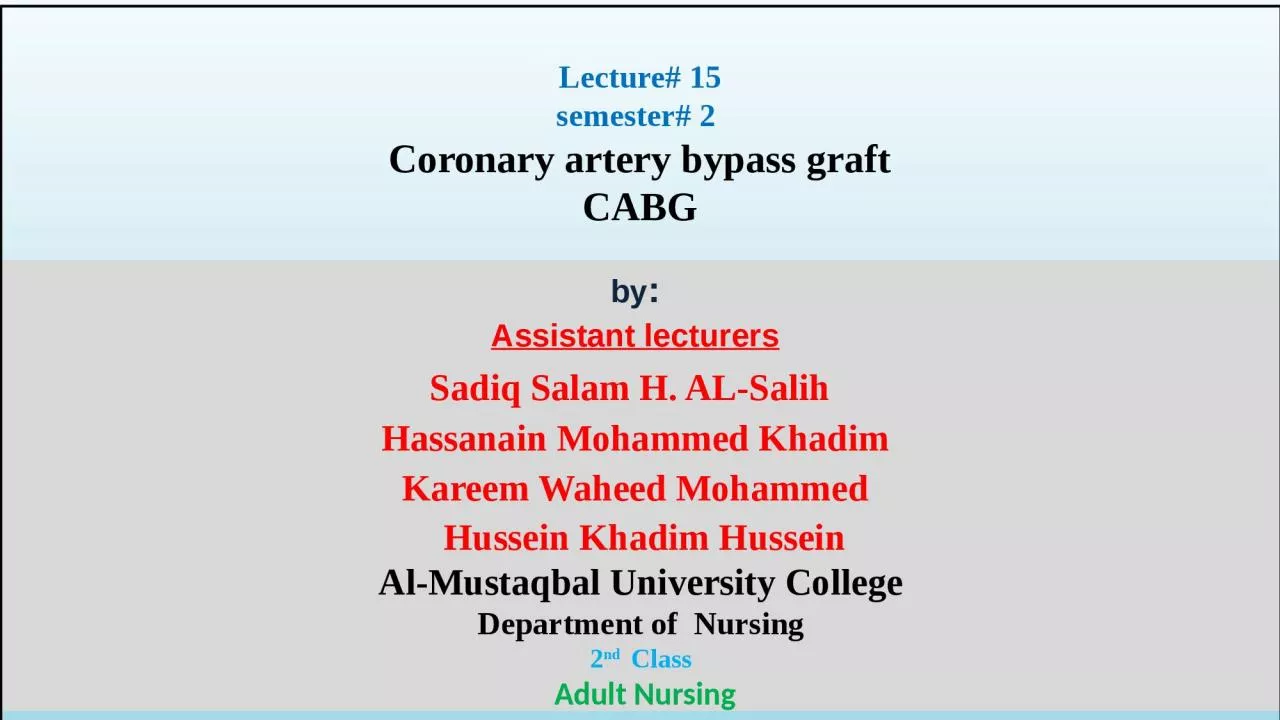

Coronary artery bypass graft CABG by Assistant lecturers Sadiq Salam H ALSalih Hassanain Mohammed Khadim Kareem Waheed Mohammed Hussein Khadim Hussein Al Mustaqbal University College ID: 1009193
Download Presentation The PPT/PDF document "Lecture# 15 semester# 2" is the property of its rightful owner. Permission is granted to download and print the materials on this web site for personal, non-commercial use only, and to display it on your personal computer provided you do not modify the materials and that you retain all copyright notices contained in the materials. By downloading content from our website, you accept the terms of this agreement.
1. Lecture# 15semester# 2 Coronary artery bypass graftCABG:byAssistant lecturers Sadiq Salam H. AL-SalihHassanain Mohammed KhadimKareem Waheed MohammedHussein Khadim Hussein Al-Mustaqbal University CollegeDepartment of Nursing2nd ClassAdult Nursing
2. Cardiac surgery is surgery on the heart or great vessels performed by cardiac surgeons. Frequently, it is done to treat complications of ischemic heart disease (for example, coronary artery bypass grafting), correct congenital heart disease, or treat valvular heart disease
3. What is CABG Coronary artery bypass graft is the surgical technique which uses saphenous leg veins as grafts (SVG) or the internal mammary (LIMA or RIMA) /radial arteries as grafts to bypass obstructed portions of a coronary artery
4. Causes of CABGStable angina but meds not controlling pain, pt has functionNon-successful PTCA) Percutaneous transluminal coronary angioplasty( with evolving MIUnstable anginaA positive exercise tolerance test [treadmill], & lesions or blockage that cannot be treated by PTCAA Left Main Coronary lesion or blockage of more than 60% (50%) Single or double vessel disease with type B or C lesions
5.
6. PREOPERATIVE DIAGONSTIC TEST ECGLaboratory (CBC, BUN, ABGs, PT, PTT)Chest x ray Echocardiogram Cardiac enzyme test (troponin )TMT
7. Standard Cardiac surgery: RequiresCPB(Cardiopulmonary bypass)Aortic cross clampingcardioplegia arrestCardiopulmonary BypassMoves oxygenated blood around the body during open heart surgeryCore body temp is lowered to 28° C to 32°
8. CPBCPB
9. Vessel Patency internal mammary artery graft 90% patency at 10 years . saphenous vein graft 50% patency at 10 years
10. Complications of CABG- Early Bleedingblood loss not to exceed 300cc/hr (200) in first several hours. After several hours should slow to 150-200 cc/hr.The average total loss is 1 literPossible bleed sites leg & chest woundscardiac tamponade- heart is compressed by blood in the mediastinal. The heart is unable to fill adequately causing low Concentration of O2 and Hypotension
11. Late Postoperative PeriodWound InfectionHepatitisPancreatitis [early or late]Systemic arterial emboli endocarditisDysrhythmias and MI Occlusion of graft
12. NURSING MANAGEMENTPreoperative Nursing Management.Intraoperative Nursing Management.Postoperative Nursing Management.
13. PREOPERATIVE ASSESSMENTHistoryPhysical examinationRadiographic examinationElectrocardiogram
14. PHYSICAL EXAMINATIONGeneral appearance and behaviorVital signsNutritional and fluid status, weight and HeightInspection and palpation of heartAuscultation of heartPeripheral pulses.Peripheral edema
15. NURSING DIAGNOSISKnowledge deficit regarding the surgical procedure and the postoperative course.Fear related to surgical procedure, its uncertain outcome, and the threat of well-being.
16. INTERVENTIONSPatient and family teaching aboutHospitalizationSurgeryLength of surgeryExpected pain and discomfort Critical care phaseRecovery phase
17. INTERVENTIONSPhysical preparation before surgeryMedications before surgeryInformation regarding equipment's, tubes that will be present postoperativelyTeaching the postoperative exercises.
18. INTRAOPERATIVE NURSING MANAGEMENTAssisting in surgical procedureContinuous monitoringMonitoring for complications: dysrhythmias, hemorrhage, MI, embolization etc.
19. POST OPERATIVE NURSING MANAGEMENTASSESSMENT:Neurological statusCardiac statusRespiratory statusPeripheral vascular statusRenal functionFluid & electrolyte status
20. POST OPERATIVE ASSESSMENT PainAssessment of equipment's and tubing'sPsychological and emotional status as patient regains consciousnessAssessing for complications.
21. NURSING DIAGNOSISDecreased cardiac output related to blood loss and compromised myocardial functionRisk for impaired gas exchange related to trauma of extensive chest surgery
22. INTEREVENTIONSMonitor cardiovascular statusAssess arterial pressure every 15 min. until stableAuscultate for heart sounds and rhythmsAssess all peripheral pulsesHemodynamic monitoringECG monitoringAssess cardiac enzymesMonitor urinary outputObserve for persistent bleedingObserve for cardiac tamponadeObserve for signs of cardiac failure Prepare to administer diuretics,digoxinObserve for myocardial infarction.
23. INTERVENTIONSMaintain proper ventilationMonitor arterial blood gases, tidal volumes, peek inspiratory Auscultate chest for breath soundsProvide chest physiotherapy as prescribedPromote deep breathing coughing and turning, use of incentive spirometer.Teach incisional splinting with a cough pillow to decrease discomfort during deep breathing and coughingSuction tracheobronchial secretions as needed, using aseptic technique
24. THANK YOU